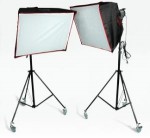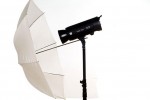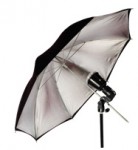Should you use a softbox, or an umbrella? Even though they serve similar purposes, which is to provide a larger light source (thereby softer light), there are several key differences between a softbox and an umbrella.
Softbox
 This is the ideal light shaping tool for portraits, because of its versatility in controlling light spill. If you are shooting inside a small room, a softbox enables you to control the spill of light. This means that the subject (the person or object you are photographing) is illuminated in soft light, while the background (walls/ceiling/floor) receives minimal, if any, light spill or light contamination. This is useful for shooting portraits that require a darker or even pitch black background. Yes, you can even create a pitch black background without the use of a black backdrop.
This is the ideal light shaping tool for portraits, because of its versatility in controlling light spill. If you are shooting inside a small room, a softbox enables you to control the spill of light. This means that the subject (the person or object you are photographing) is illuminated in soft light, while the background (walls/ceiling/floor) receives minimal, if any, light spill or light contamination. This is useful for shooting portraits that require a darker or even pitch black background. Yes, you can even create a pitch black background without the use of a black backdrop.
A softbox makes creating flattering portraits very easy. You can use it as a key light, fill light or even a hair light. It all depends on the lighting conditions at the location you are shooting.
There are several types of very portable softboxes that you can get. Get the largest one available, as it produces the softest light. The softbox has 2 baffles to filter and soften light even further.
Umbrella
The umbrella’s distinct advantage is portability and mobility. You can bring several umbrellas on an outdoor shoot without any inconvenience. When opened, they provide beautiful soft light, by converting your light (speedlight or a more powerful monolight with battery pack) to a larger light source.
What the umbrella lacks in comparison to a softbox is control of light spill. When used indoors, an umbrella lights up a large part of the room, decreasing your control over how dark your background can be.
There are also different types of umbrellas.
 A shoot-through is a translucent white umbrella which your light shoots through and onto the subject. The umbrella shaft is pointed away from the subject, thereby reducing any chances of it accidentally injuring your subject.
A shoot-through is a translucent white umbrella which your light shoots through and onto the subject. The umbrella shaft is pointed away from the subject, thereby reducing any chances of it accidentally injuring your subject.
 The other type is a reflective umbrella, where your light shoots into, and then bounces back onto the subject. This type of umbrella inevitably has its shaft pointing at the subject, so you can’t really go in as close as a shoot-through umbrella would allow. The closer you get to the subject, the softer the light. As the light wraps around the subject, it reduces harsh shadows.
The other type is a reflective umbrella, where your light shoots into, and then bounces back onto the subject. This type of umbrella inevitably has its shaft pointing at the subject, so you can’t really go in as close as a shoot-through umbrella would allow. The closer you get to the subject, the softer the light. As the light wraps around the subject, it reduces harsh shadows.